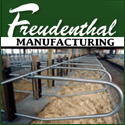Ooops!
Sorry, the requested news story could not be found.
Other National & World Ag News Headlines
- Gov Shutdown Hits Crucial Tools for Farmers, Traders
- Students to Take Part in Gateway to Ag Careers Program
- ChapterBoost Connecting Donors to FFA Chapters
- BASF Announces EPA's Approval of Zorina Fungicide
- Canadian Farm Equipment Sales Reported Higher
- Fertilizer Outlook Shows Global Risk, Higher Costs
- Pork Producers Pushing for Fix to Prop. 12



